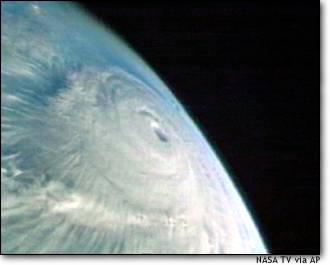
Being a native Houstonian, it stands to reason that the first natural disaster that I was aware of being a part of was Hurricane Alicia in 1983. Being situated less than 60 miles from the Gulf of Mexico; Houston is an annual participant in ‘Hurricane Season’. It’s a period of time between June 1 and November 30, that hurricanes occur.
They start as tropical disturbances, usually off the coast of western Africa. Thunderstorms falling down over the warm ocean start the wind patterns, and once the wind speeds exceed 39 mph, they are then called Tropical Storms. When winds hit 74 mph or more, a tropical storm takes a cyclonic form and becomes a hurricane. The severity of hurricanes is measured on the Saffir-Simpson Scale (1-5) with 5 being the highest with winds 155+. The deadliest hurricane in U.S. history, a category 4 by today’s standards, killed over 8,000 people in Galveston, Texas in 1900.
The picture above is a NASA satellite image of Hurricane Isabel that is currently in the Atlantic and heading toward the eastern coast of the United States. With its current force and size (115 mph, Category 3), meteorologists are predicting a landfall sometime around Thursday somewhere along the Carolinas. Living through an experience such as Alicia reminds me of how important it is to be as prepared as possible for natural occurrences such as a hurricane. The National Hurricane Center and Red Cross have a common checklist of 10 steps and procedures to follow to prepare for a potentially severe hurricane:
1. Money: Make sure you have cash and credit cards in your possession in the event you need to evacuate. Also get a copy of your homeowner’s insurance policy.
2. Escape route: Have multiple escape routes and know the proper government evacuation route. Make sure you car's fuel tank is filled and your mobile phone is charged.
3. Escape Shelter: Identify ahead of time where you could go if told to evacuate. Choose several places, like a friend's home in another town, a motel or a shelter.
4. Supply Kit: Assemble a disaster supplies kit including the following items:
• First-aid kit and any essential medications.
• Canned food and can opener.
• At least three gallons of water per person.
• Protective clothing, rainwear and bedding or sleeping bags.
• Battery-powered radio, flashlight and extra batteries.
• Special items for infants, elderly or disabled family members.
• Written instructions on how to turn off electricity, gas and water if authorities advise you to do so. (Remember, you'll need a professional to turn them back on.)
5. Prepare Interiors: If evacuating, unplug all electrical devices. Shut off natural gas if local officials advise it and make sure to have a sufficient supply of batteries for battery-powered equipment.
6. Prepare Exteriors: Secure your home by boarding over windows or putting up hurricane shutters. If you use boards, purchase precut one-half-inch outdoor plywood boards for each window of your home. Install anchors for the plywood and drill holes in the plywood ahead of time, so it can be installed quickly.
7. Clear Dead Trees: If you live in a wooded area, make trees more wind-resistant by taking out diseased and damaged limbs, then strategically removing branches so that wind can blow through.
8. Avoid Danger Areas: Move to safe shelters. Low-lying areas and mobile homes should be evacuated.
9. Stay informed: Stay informed by monitoring weather advisories on radio and television. If advised to evacuate, do so immediately.
10. Clean Up the Yard: If a hurricane watch is issued, prepare to bring inside any lawn furniture, outdoor decorations or ornaments, trashcans, hanging plants and anything else that can be picked up by the wind.
These are some time-tested steps of precaution and safety that have helped many potential victims over the years. Of course, the most important thing of value is human life and these steps are designed to save as many as possible. Going through an experience like Hurricane Alicia, with its 130+mph winds and heavy rains can be a humbling experience. Flash flooding, dissected power lines, ruptured water tanks, phone lines down, it got pretty bad and there was nothing man could do to stop it. As Alicia was passing over the Southside, I was awestruck by its sheer force. It had already swept through Galveston and the path didn’t look pretty. As the heavy rains increased, as did the wind, I wondered if we would be like one of those homeless people living in sleeping bags at the Y because their house was destroyed. Just when I thought our house would not be able to take anymore…there was a calm. The wind stopped..the air was clear..the rain ceased. I walked outside with my father and we could actually see blue skies and the sun come out.
Is it over?
No son..this is what’s called the eye of a hurricane.
The eye?
They call it the eye, but it’s really the center point of the hurricane, that’s what’s passing over us right now.
How weird. Right in the middle of one of the fiercest storms in American history was calm. Peace. It was downright eerie. After Alicia blew through, we were without electrical power for over 7 days. Fortunately, we were all safe and our home remained intact, as the flooding waters never got up into the house. So keep a radio and batteries handy and stay tuned to the news reports, keep flashlights and candles available, as well as a good book and some games to play. The storm won’t last forever, just make sure you do all you can so that YOU last through it.
Copyright © 2003 www.servinemup.com All Rights Reserved